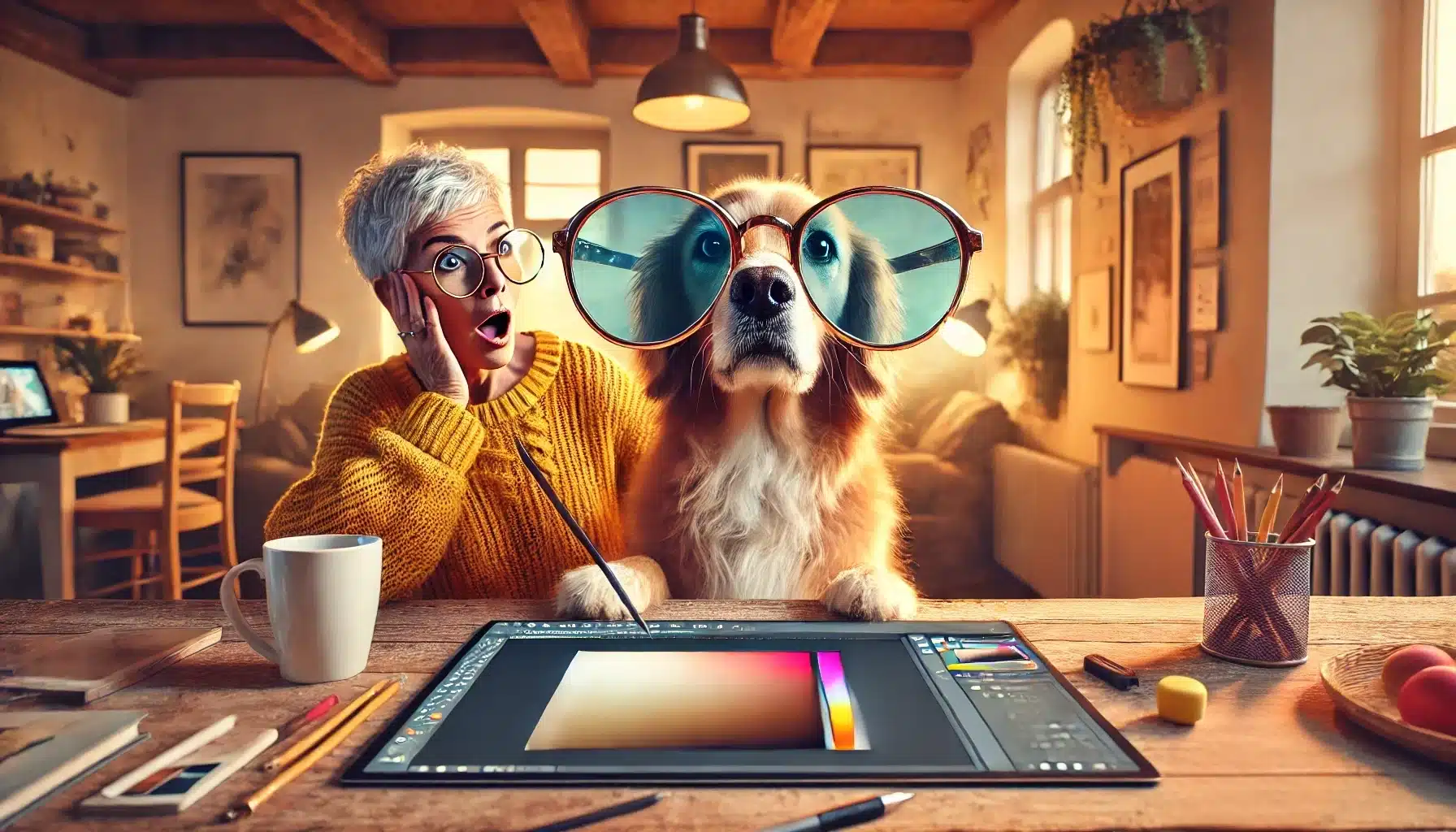
In this article, I’ll guide you through the steps to master glasses Photoshop, ensuring every image looks flawless. We’ll dive into practical techniques that capture attention by addressing common issues like how to remove glare and distortion.
I’ll keep you interested with easy-to-follow methods that even beginners can grasp quickly. As we progress, your desire to enhance your photo-editing skills will grow.
Finally, I’ll show you actionable steps to apply these tips in your own projects.
Let’s get started on transforming your photos into stunning works of art!
Table of Contents
Understanding Glasses Photoshop
Glasses in photos can often pose challenges, but with Photoshop, you can make them look flawless. Let’s explore how this powerful tool can enhance images featuring glasses.
What is Glasses Photoshop?
Photoshop helps us fix photos and make them look better. When you take a picture of someone wearing glasses, you sometimes see glare.
This glare from glasses Photoshop can ruin a great picture. A Photoshop tutorial can show you how to remove glare from glasses and make the photo clear.
We use tools like the brush tool, clone stamp tool, and the content-aware fill in Photoshop to do this.
Why Remove Glasses Photoshop Glare?
Remove glare from glasses makes the person in the photo visible. It helps focus on their face and eyes. When you reduce or remove glare, the photo looks more natural.
When you remove glare, it makes it easier to perform other edits.
Steps to Remove Glare
Follow these simple steps to effectively remove glare from glasses Photoshop.
- Open the photo: First, open your photo in Photoshop. Simply click on the new layer icon to add a new layer.
- Select the tools: Use the brush tool, the cloning tool, or the content-aware fill in Photoshop to remove glare. The cloning tool lets you copy a part of the image and cover up the glare. Press the alt key for Windows or the option key for Mac to select an area to clone.
- Adjust the tools: You can change the brush size and hardness to match the glasses glare. If using the brush, pick a color similar to the part with glare. Adjust opacity to blend well.
- Start editing: Carefully paint over or clone the glare from the glasses Photoshop. Go slow to make sure it's neat. You can use the dehaze slider to help remove glare, particularly in digital negatives or raw files.
- Work with layers: Always use layers. This way, you don't destroy the original image. You can adjust editing layers if needed for different light conditions.
- Final touches: Use the camera raw filter to fine-tune the photo. Adjust colors, contrast, and other details.
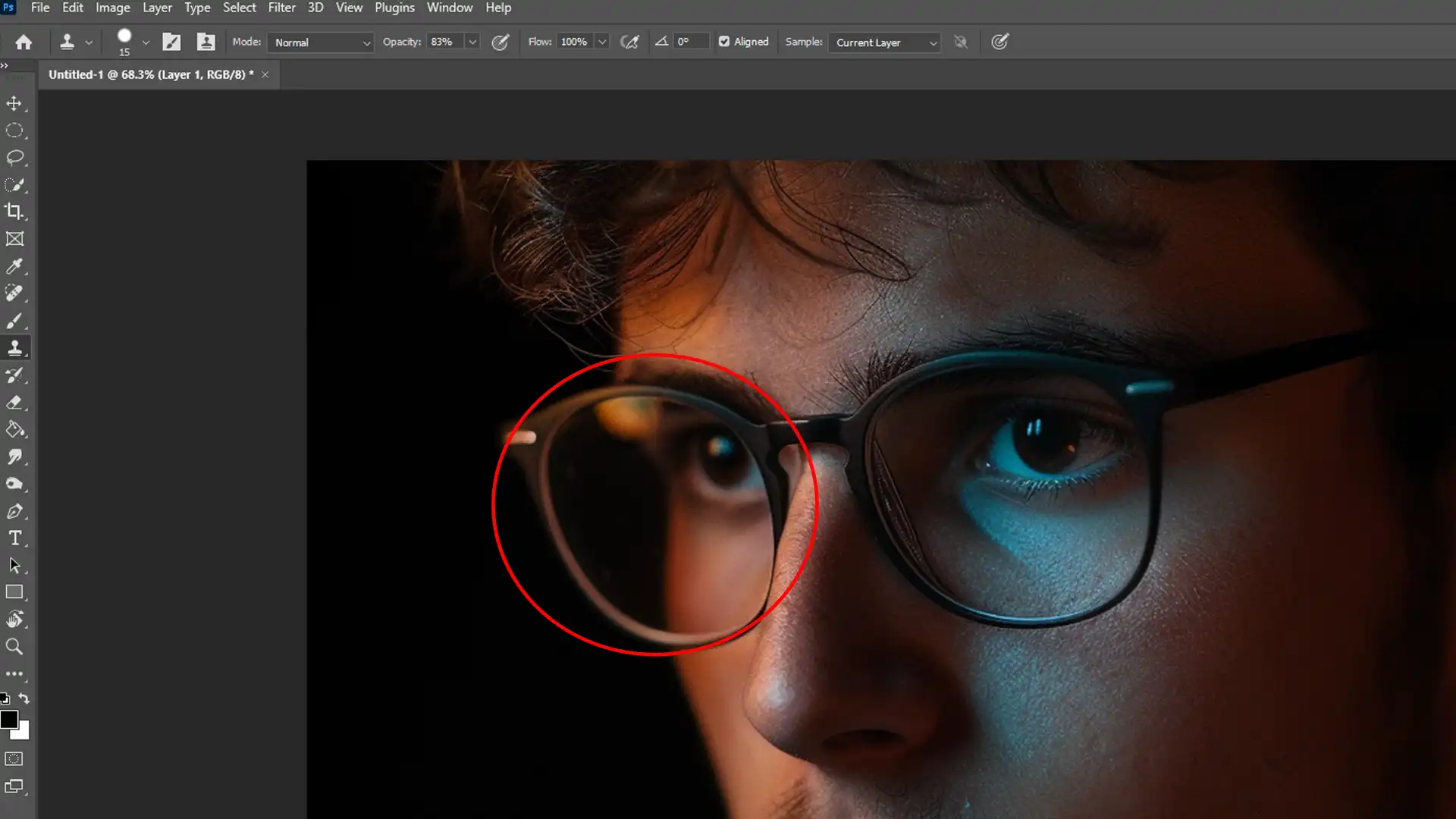
Pro Tip: Using a correction layer like levels or curves can help remove glare naturally, especially when working on camera photos. If you’re learning how to remove an object and how to remove the background, these techniques can be just as effective.
Remember to save your work frequently.
How to Remove Glasses Glare in Photoshop
Removing glasses glare in Photoshop is significant for more natural-looking photos. It’s quite straightforward if you follow the right steps. Here, I’ll break it down for you.
Glasses Photoshop: Step-by-Step Guide to Remove Glare
To achieve a glare-free photo, follow this guide using Photoshop.
- Start by opening your image in Photoshop.
- Add a new layer to protect the original photo.
- Use tools like the brush, cloning tool, and content-aware fill.
- Keep adjusting until you remove glare from the image.
- Use adjustment layers like levels or curves for final touches.
Using the Clone Stamp Tool
First, you need to select the tool. You can do this by pressing “S” on your keyboard, which is a handy keyboard shortcut. To remove glare from one lens, select a source point near the glare area using the option key (Alt on PC).
Carefully paint over the glare. Make sure to sample frequently to blend it well with the surrounding areas. Make repetitive light strokes, avoiding harsh lines.
Using the Brush Tool
Select the brush from the toolbar or press “B” on the keyboard. Choose a soft brush. Adjust the opacity and flow rate for smoother blending. Begin by painting over the area on one lens where you want to remove glare.
Use a low-opacity setting and blend the area gradually. Repeat until the glare blends seamlessly into the photo.
After these steps, don’t forget to use a color layer like levels or curves to make the colors and contrasts through the lens just right. Check everything in the layer interface to ensure nothing looks odd.
Pro Tip: Save your work frequently! This way, you won’t lose any progress if something goes wrong.
Glasses Photoshop: Advanced Techniques for Removing Glare
You know that removing glare is often tricky. But with some practice, it’s quite manageable
Using Adjustment Layers
Adjustment layers are powerful. They help you tweak your image non-destructively.
Follow these steps to use these layers:
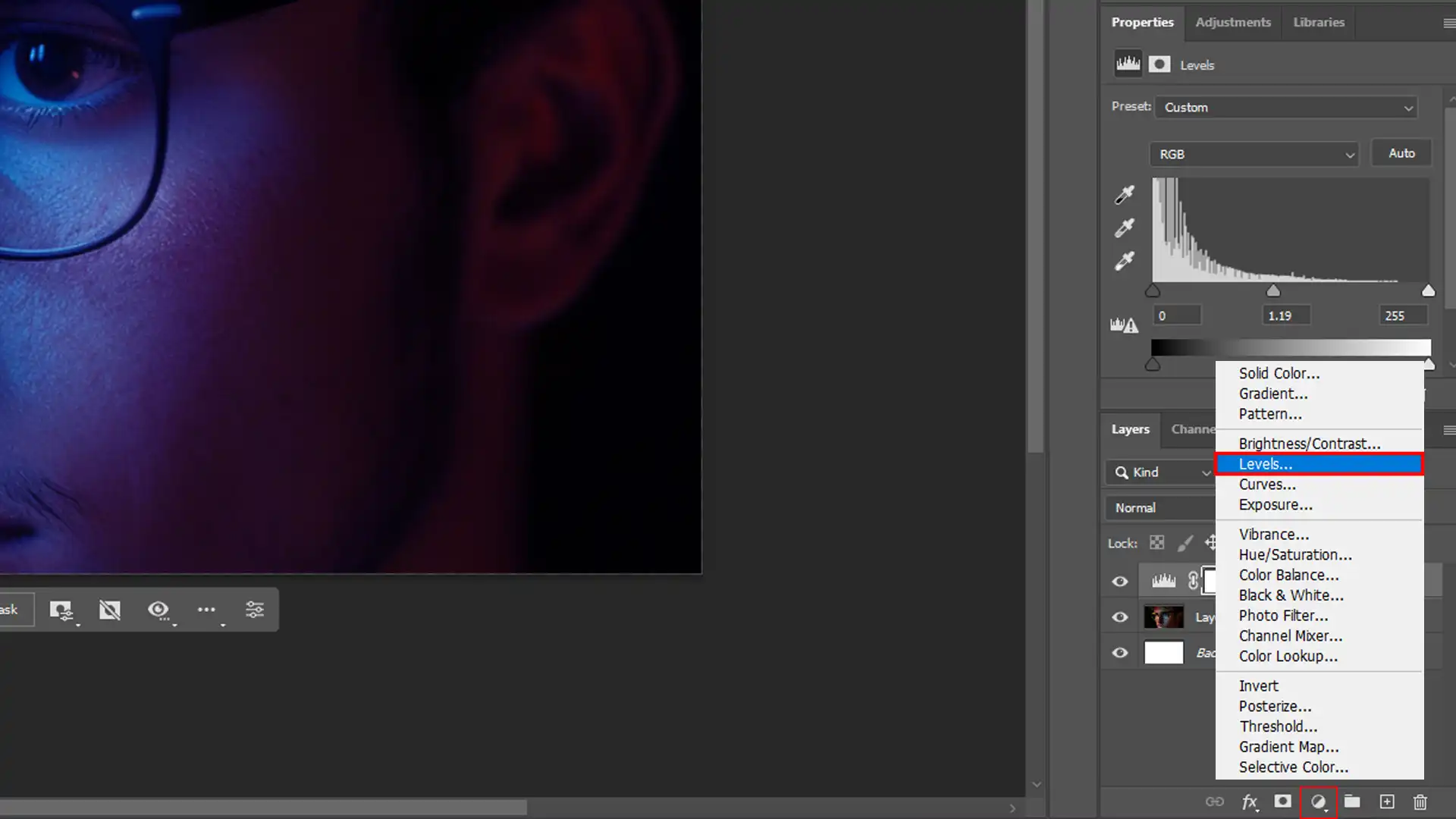
- Add an Adjustment Layer: Start by opening your Photoshop project. Go to the 'Layers Panel.' Click on the adjustment layer icon at the bottom. Choose 'Levels' or 'Curves.'
- Set the Midtones: In the dialog box that opens, drag the midtone slider left or right. This step adjusts the light intensity.
- Use the Feather Slider: Select a mask for the adjustment layer. In the properties panel, modify the feather slider for smooth edges.
- Always Check: Evaluate the adjustments by turning the layer on and off. This way, you can confirm that the adjustments effectively remove glare without affecting other parts of the image.
Combining Multiple Tools in Glasses Photoshop
Sometimes, one tool isn’t enough. You might need a combination for perfect results.
Use these tools to combine:
- Brush: Create a new layer. Select the brush and set its opacity to low. Brush over the glaring areas slowly and steadily.
- Clone Stamp: Press 'S' on the keyboard to activate it. Alt-click to sample a nearby area, then brush over the glare. This blends the light differences well.
- Content-Aware Fill: Select the glaring area with any selection tool. Go to Edit > Content-Aware Fill. Photoshop fills the area using nearby colors and textures.
- Adjustment Composite: Create multiple modification layers if needed. Use the levels layer to darken the glare. Use the color layer to match the surrounding colors better.
Remember, practice makes perfect. So, play around and find what works best for each image.
Pro Tip: Always work on a new layer. This keeps your original photo safe. If mistakes happen, you can easily revert back.
For more tips on photo editing, check out our Learn Photoshop section and explore the essential tools in Photoshop, as well as the Difference Between Photoshop and Lightroom to understand which software suits your needs better.
How to Remove Scenic Glare (Flare) in Photoshop
Removing scenic glare in glasses Photoshop can dramatically improve your photos. Follow these steps to clear up any distracting flare and enhance your image.
Open Your Image in Photoshop
First, open your desired image in Photoshop. You can do this by clicking “File” and then “Open“. Select the image you want to edit. Let’s remove glare from the image
Duplicate the Original Image Layer
In the layers panel, right-click your original image layer and select “Duplicate Layer”. This way, you keep the image intact.
Create a New Layer
Next, click on the new layer icon at the bottom of the layers. This new layer will be used for the edits.
Use the Clone Stamp Tool to Remove Glare
- Select the cloning tool from the toolbar or simply press the shortcut “S”.
- Hold down the Alt key if you’re on Windows or the option key if you’re on a Mac to sample an area near the glare.
- Carefully brush over the glare with the cloning tool.
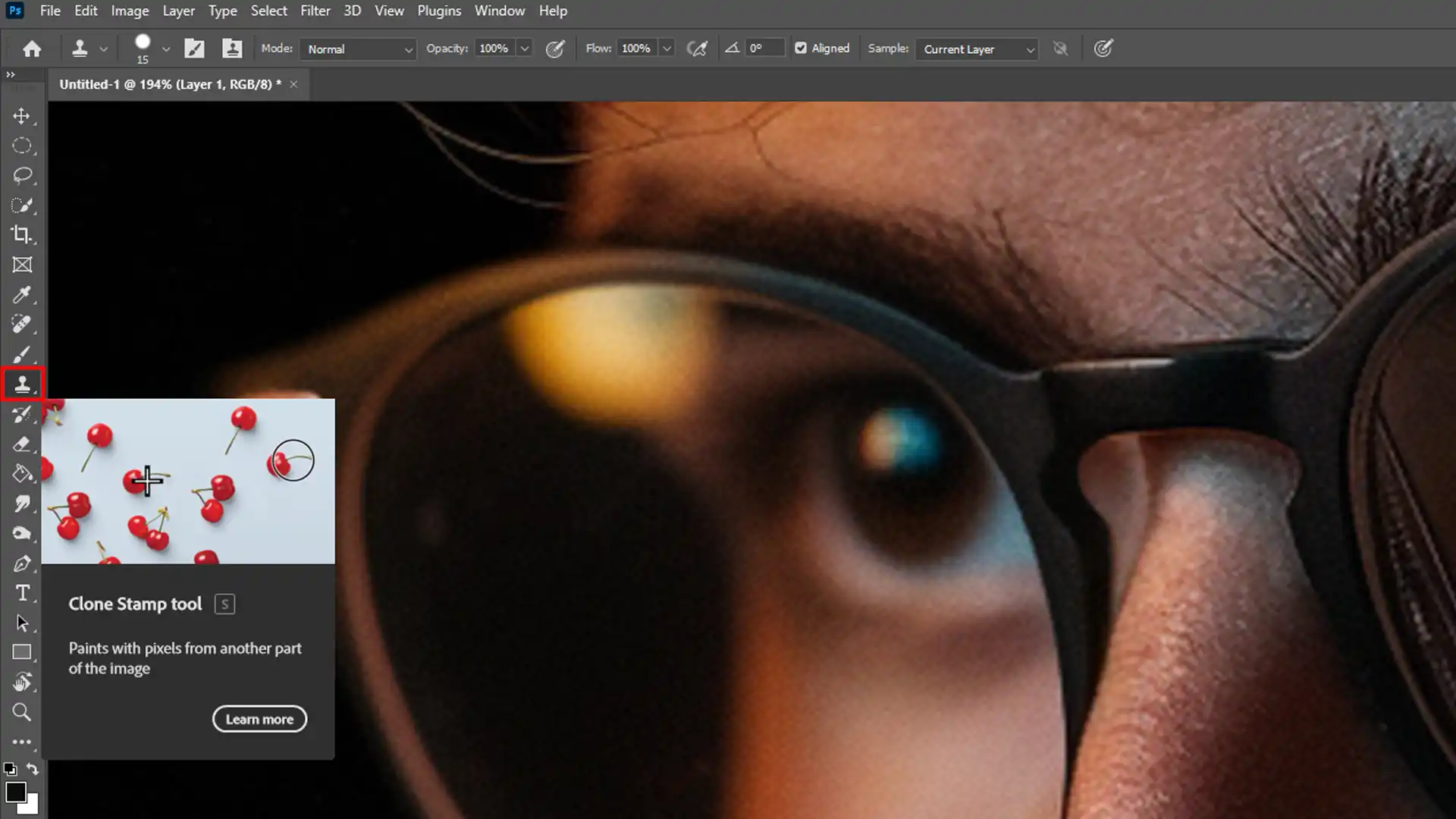
Utilize the Brush for Fine Adjustments
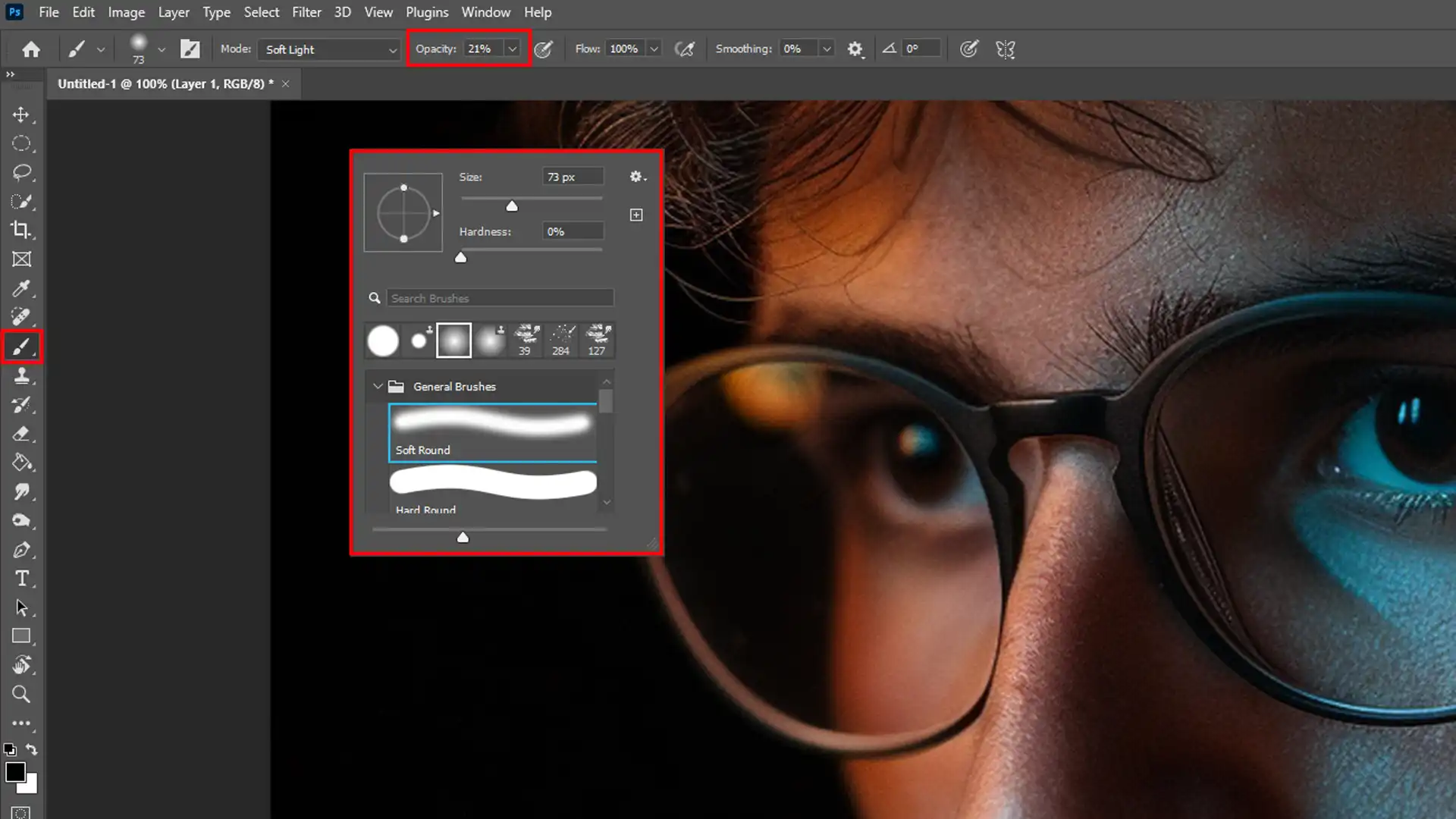
- If some glare remains, select the brush by pressing “B”.
- Use a soft brush to brush over any stubborn glare areas.
- Modify the opacity of the brush if necessary.
Refining Your Edits with Adjustment Layers

- Go to the layers panel and click on the new adjustment layer icon.
- Select “Brightness/Contrast”.
- Tweak the settings to blend the edited area with the original photo.
Save Your Image
- Once you are satisfied with the glare removal, save your image.
- Click “File”, then “Save As”.
- Choose the file format you prefer and hit “Save”.
Pro Tip: Use a different angle when taking photos, minimizing glare from glasses and other glossy surfaces in the first place.
Stepping up your initial photography techniques, like learning how to photograph shiny objects and removing shadows effectively will save you editing time.
For more advanced edits, consider using the Content-Aware Fill in Photoshop to seamlessly remove unwanted elements.
Tips and Tricks for Better Glasses Photoshop Results
Enhance your photo editing skills with these practical tips. Learn how to fine-tune your edits for a polished, professional look.
Explore these important tips and techniques to enhance your glasses Photoshop editing skills. The table below provides a quick overview of each aspect
| Aspect | Overview |
|---|---|
| Work on a New Layer | Always work on a new layer to keep your original photo safe, allowing you to experiment without fear. |
| Remove Glare from Glasses Photoshop | Use tools like the adjustment layer, brush, clone stamp, and content-aware fill to effectively remove glare from glasses in Photoshop. |
| Light Adjustments | Utilize the layers panel to apply soft lighting adjustments that complement your subject and remove unwanted glare. |
| Dehaze Slider | Use the dehaze slider in Lightroom to remove glare and enhance the overall clarity of your photos. |
| Combining Tools and Techniques | Combine multiple tools and techniques to achieve better results, such as modifying midtones and using feather sliders for smooth edges. |
| Practice Makes Perfect | Consistently practicing these methods will improve your skills and confidence in achieving desired outcomes. |
Fine-Tuning Your Edits in Glasses Photoshop
Are you trying to perfect your photos? Let’s explore some tips to fine-tune your edits.
Whether you’re working in Photoshop or Lightroom, these methods can help you achieve the best results. We’ll start with how to remove glare, a common issue when photographing subjects wearing glasses.
Work on a New Layer
First, always work on a new layer. This ensures your original photo stays intact, allowing you to experiment fearlessly.
Remove Glare from Glasses Photoshop
To remove glare from glasses Photoshop, here are a few tools and techniques:
- Adjustment Layer: This method helps you tweak your photo without altering the base layer. In Photoshop, create an adjustment layer and work on it. Check your progress by toggling it on and off.
- Brush: Use this tool to brush over glaring areas. Lower the opacity for a natural look.
- Clone Stamp: Sample nearby areas and paint over the glare. This method can blend glaring spots smoothly.
- Content-Aware Fill: Select the glaring area and use this tool to fill it with nearby colors and textures. This approach works well for larger areas of glare.
Light Adjustments
Furthermore, light adjustments can make a big difference. Utilize the layers panel to apply soft lighting adjustments that complement your subject.
This is also true when working on the 3D glasses effect in Photoshop.
Dehaze Slider
When editing a RAW file, the dehaze slider in Lightroom can also be beneficial. It helps to remove unwanted glare and enhances the overall clarity.
Combining Tools and Techniques
Combining multiple tools and techniques often yields better results. Don’t hesitate to modify the midtones and use feather sliders for smooth edges. Experiment with different angles to see which works best.
Practice Makes Perfect
Finally, practice makes perfect. Consistently experimenting with these methods will improve your skills and make you more confident in achieving desired outcomes.
Pro Tip: Always keep a backup copy of your original photo. You never know when you’ll need to start over or rest and try a different approach.
With these tips and tricks, you’re well on your way to mastering photo edits. Delve in and start experimenting!
Glasses Photoshop: Common Mistakes to Avoid
It’s easy to make mistakes while editing images in Photoshop. Recognizing these errors can help improve your skills quickly.
Not Using Layers Properly
One common mistake is not using layers. Never work on your original photo directly. Always create a new layer. Use the layers panel to stay organized.
Ignoring Exposure Adjustments
Sometimes you ignore exposure adjustments and end up with harsh light. Always tweak exposure settings. This step helps manage light better.
Overusing the Brush
Overuse of the brush at full opacity can make edits look fake. Lower the opacity and build up the color gradually.
Incorrect Use of Clone Stamp Tool
Using the clone stamp tool without care can result in obvious patches. Sample close areas and blend carefully to avoid visible edits.
Neglecting Content-Aware Fill
You might forget the content-aware fill feature. This tool fills larger areas of glare seamlessly. It’s a lifesaver for tricky spots.
Missing Light Adjustments
Always modify the light settings. The layers panel has options for subtle light effects. This makes the photo look natural.
Not Using Dehaze Slider in Lightroom
In Lightroom, this slider is your friend. It helps remove glare and enhance photo clarity. Don’t overlook it.
Failing to Combine Tools
Relying on just one tool can limit your editing potential. Mix and match the tools available. Modify midtones, use feather sliders, be flexible.
Not Practicing Enough
Practice makes perfect. Keep editing and experimenting. Your skills and confidence will grow with each session.
Pro Tip: Always keep a backup of your original photo. It provides the flexibility to rest, revisit your edits, and ensures you never lose your initial work.
Avoiding these common pitfalls will significantly improve your editing workflow. You don’t need to be perfect, just be consistent and mindful of these tips.
Frequently Asked Questions

How do I add glasses in Photoshop?
- Open your image in Photoshop.
- Select the 'Layer' menu, then 'New' and 'Layer' to create a new layer.
- Use the 'Pen' tool or 'Brush' tool to draw glasses shapes. You can also import a glasses image and adjust it to fit.
- Position the glasses on the subject's face and use tools like 'Erase' or 'Smudge' to blend edges.
Where is the glass effect in Photoshop?
- Go to the 'Filter' menu.
- Choose 'Render' and then 'Lens Flare' for a basic glass effect.
- For more specific glass effects like frosted glass, use 'Filter Gallery' under the 'Filter' menu and explore options under 'Texture'.
Can you remove glare from glasses Photoshop?
- Open your image and zoom in on the glare.
- Select the 'Cloning Tool' or 'Healing Brush' from the toolbox.
- Alt-click (Option-click on Mac) on an area near the glare to sample it.
- Gently brush over the glare to blend it into the surrounding area.
Where is the eye tool in Photoshop?
- The tool you might be looking for is the 'Red Eye Tool'.
- Find it in the toolbox, usually grouped with the 'Healing Brush' tools.
- If not visible, right-click on the 'Healing Brush' to see more options; then select the 'Red Eye Tool'.
Conclusion
In conclusion, mastering “glasses Photoshop” has been a game-changer for my photo editing process. Whether I needed to remove reflections or add stylish frames, the techniques I learned have transformed my work.
It’s incredible how a few simple steps can make such a significant difference.
If you’re looking to improve your skills, I highly recommend checking out this comprehensive Photoshop course and this in-depth Lightroom course.
These resources have been invaluable in my journey, and I’m confident they will help you achieve amazing results too.
Read more about Photoshop:
















